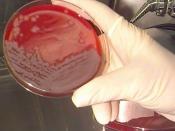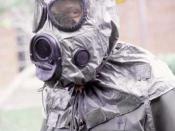Chemical and biological warfare is the wartime use of chemicals, bacteria, viruses and toxins to seriously injure or kill soldiers and civilians (Chemical and Biological Warfare, 1999). The borderline between chemical and biological warfare agents has started to lose importance as a result of the rapid development of biotechnology (Chemical and Biological Warfare, 1999). Biotechnology has enabled the large-scale production of new types of substances (Chemical and Biological Warfare, 1999). Poisonous gases that are able to damage nerves, blood, or skin and lung tissues are one form of chemical weapons. Chemical agents may be volatile, which is they are able to evaporate rapidly to form clouds of the agent. Some chemical agents may be absorbed by skin or lungs, which cause injury. Some chemical agents are able to act directly on skin, lungs, and membranes (Null, 2003). As chemical weapons are dispersed they become less lethal.
Some chemical agents are so strong that they exceed the toxicity of nerve agents by several orders of magnitude. In the long run chemical weapons may become an even more serious threat.
Biological warfare, often called "germ warfare", has never actually been employed on the battlefield (Chemical and Biological Warfare, 1999). An aerosol spray can is able to disperse a biological agent but the contents must be inhaled to have any effect. Biological warfare agents include both living microorganisms and toxins produced by microorganisms, plants, or animals (Null, 2003). A biological agent, if properly dispersed can be immensely destructive and lethal to plant, animals and humans. Biological agents have the ability to multiply and self perpetuate in the perfect environment. Food, water, and other products can be contaminated by biological agents. When biological weapons mutate it frustrates protective measures greatly. It is a fact that substantial...


